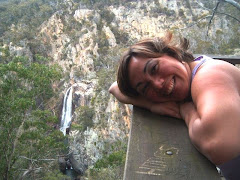Another action-packed day!
Hilary, Trinity, Juanita, Scott and I headed into town. Juanita gave the girls a digital camera to play with and that was the start of a fun filled and special day.
We toured around the downtown of St. John's showing Juanita the sights, the girls giggling and clicking away and Scotty being silly and playing thumb wars and tickling meant the back seat was gales of laughter whilst Juanita and I did the tour guide/tourist thing up front.
I do not know why this photo was taken, which is why I include it now as I am sure the girls took it in their snappy-s...

We arrived on Signal Hill admist- you guessed it- Fog and WIND!
 The Lower Battery is still one of my favourites...
The Lower Battery is still one of my favourites...

 Hilary and Trinity were learning all about the wireless transmission Marconi sent and how pop used to volunteer here.
Hilary and Trinity were learning all about the wireless transmission Marconi sent and how pop used to volunteer here.

 We drove around downtown some more appreciating Jelly Bean Row
We drove around downtown some more appreciating Jelly Bean Row
 And then went to Ches' for lunch- yum-o! We all had fish and chips of course and we got certificates also as we were visiting from (CBS) Australia. Uncle Scotty agrees with Trinity that this is the BEST fish and chips. (Okay, maybe the rest of the province share the secret also...)
And then went to Ches' for lunch- yum-o! We all had fish and chips of course and we got certificates also as we were visiting from (CBS) Australia. Uncle Scotty agrees with Trinity that this is the BEST fish and chips. (Okay, maybe the rest of the province share the secret also...)
 Back seat thumb war action took us back to Signal Hill to the GEO Centre
Back seat thumb war action took us back to Signal Hill to the GEO Centre
 The Johnson GEO CENTRE is housed in one of the most distinctive buildings in the province, on a beautiful property next to Signal Hill National Historic Site.
The Johnson GEO CENTRE is housed in one of the most distinctive buildings in the province, on a beautiful property next to Signal Hill National Historic Site.
The large, glass-encased entry is the only part of the building above ground. Most of the floor space are underground — right inside of the solid rock walls!

At the GEO CENTRE, we heard stories behind the radical changes that take place in our climate; and the constant, all-powerful influences of the Sun and our Earth’s gravity. And we got to see what lies far beyond our planet, into the far reaches of outer space, where science tells us how our Earth’s future is unfolding.
Even the heating system is unique. The GEO CENTRE is heated by the Earth itself, through holes drilled over 150 metres into the rock, using heat pumps to circulate fluids that heat or cool the building. The GEO CENTRE's main exhibits start off in a state-of-the-art theatre that takes you back through the story of Earth, unleashing the power of volcanoes, earthquakes, and torrential rainstorms- it was really cool and Gordon Pinsent was the narrator!
The rest of the exhibits area is divided into four sections — Our Planet, Our Province, Our People, and Our Future.
 These exhibits feature displays that present the forces that shaped our planet, climate changes, and the comparatively short time span of humankind.
These exhibits feature displays that present the forces that shaped our planet, climate changes, and the comparatively short time span of humankind.
The external walls of the Exhibits area are of natural, 550 million year old exposed rock; you can see the features and characteristics of Signal Hill’s geology. On days of heavy rain or snowmelt the fractures and cracks within the rock walls provide natural channels for water migration, so that the walls themselves become wet as water seeps through the rocks.
 From the main lobby, is a breathtaking, full-colour planets of our solar system, hanging within the three-storey high Reception Hall. It's simply spectacular. This photo just does not get the mamoth display in context, now how beautiful it looks up close- but here it is anyway...
From the main lobby, is a breathtaking, full-colour planets of our solar system, hanging within the three-storey high Reception Hall. It's simply spectacular. This photo just does not get the mamoth display in context, now how beautiful it looks up close- but here it is anyway...

There are so many beautiful NASA photographs of galaxies, nebulae, distant stars, and other sights from space.


No doubt you have seen me use this figure before (on facebook). It is an Inukshuk. 
The mysterious stone figures known as inuksuit can be found throughout the circumpolar world. Inukshuk, the singular of inuksuit, means "in the likeness of a human" in the Inuit language. They are monuments made of unworked stones that are used by the Inuit for communication and survival. The traditional meaning of the inukshuk is "Someone was here" or "You are on the right path."
The Inuit make inuksuit in different forms for a variety of purposes: as navigation or directional aids, to mark a place of respect or memorial for a beloved person, or to indicate migration routes or places where fish can be found. Other similar stone structures were objects of veneration, signifying places of power or the abode of spirits. Although most inuksuit appear singly, sometimes they are arranged in sequences spanning great distances or are grouped to mark a specific place.
These sculptural forms are among the oldest and most important objects placed by humans upon the vast Arctic landscape and have become a familiar symbol of the Inuit and of their homeland.
Leaving the GEO CENTRE, we came across a vehicle we would very much like to have been driving- that looks like so much fun!!

Now we are off to get married again and then head across the Island to Gros Morne National Park! Talk to you soon!!! xox
 The Salmonier Nature Park is quite different from people's perception of a zoo. The overall design and broad environmental education mandate sets Salmonier Nature Park apart from most similar facilities.
The Salmonier Nature Park is quite different from people's perception of a zoo. The overall design and broad environmental education mandate sets Salmonier Nature Park apart from most similar facilities. The layout of the Park is based on a nature walk. The animals are in large natural enclosures scattered along the park trail, which allow visitors to see animals that are part of their natural surroundings, not divorced from them, and which also encourage visitors to feel they are part of these surroundings.
The layout of the Park is based on a nature walk. The animals are in large natural enclosures scattered along the park trail, which allow visitors to see animals that are part of their natural surroundings, not divorced from them, and which also encourage visitors to feel they are part of these surroundings. Salmonier Nature Park takes people into the landscape where the animals are displayed in settings that are as natural as possible.
Salmonier Nature Park takes people into the landscape where the animals are displayed in settings that are as natural as possible.  The emphasis at Salmonier Nature Park is on quality, not quantity.
The emphasis at Salmonier Nature Park is on quality, not quantity.

 Unless an animal can be displayed well, it is not displayed at all.
Unless an animal can be displayed well, it is not displayed at all.
 Most display animals come to the Park injured and unreleasable. Because of the naturalistic displays and the need to balance the needs of the animal and the desire of people to see them, the Park does not guarantee that the animals will be 100% visible. Most visitors see about 80% of the animals.
Most display animals come to the Park injured and unreleasable. Because of the naturalistic displays and the need to balance the needs of the animal and the desire of people to see them, the Park does not guarantee that the animals will be 100% visible. Most visitors see about 80% of the animals. 































 We drove around downtown some more appreciating Jelly Bean Row
We drove around downtown some more appreciating Jelly Bean Row
 Back seat thumb war action took us back to Signal Hill to the GEO Centre
Back seat thumb war action took us back to Signal Hill to the GEO Centre

 These exhibits feature displays that present the forces that shaped our planet, climate changes, and the comparatively short time span of humankind.
These exhibits feature displays that present the forces that shaped our planet, climate changes, and the comparatively short time span of humankind. 











